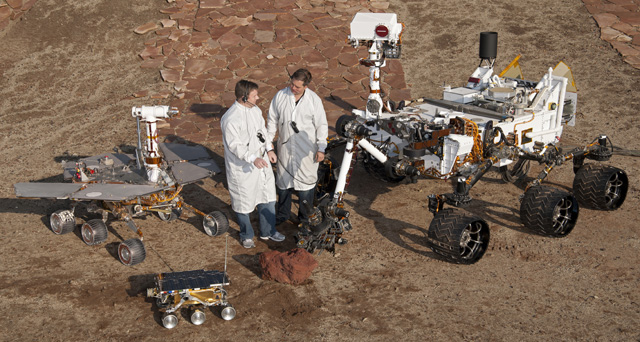NGINX to Mars will bring

Comparative dimensions of rovers. Curiosity - right
Rover Curiosity was the most perfect space apparat ever built - our specialists took part in its creation. For example, a nanothermal neutron detector to determine the density of hydrogen in the atmosphere of Mars was created and built at the Space Research Institute of the Russian Academy of Sciences. And public servers with sites of the Mars exploration program work on the Nginx server written in Moscow.
Even during the planning mission for the landing and operation of Curiosity, NASA specialists made sure that everyone could see the broadcast from the surface of Mars. NASA had two tasks - to afford a large number of Internet visitors and to make sure that the site nasa.gov did not suddenly collapse. After some thought, NGINX was chosen for this purpose.
')
“The advantage of the server is that it is used for sites with a large amount of traffic. Nginx is a Russian server developed by programmer Igor Sysoev. The video that comes from the rover is transmitted via the space communications system to Earth, and then distributed to everyone with the help of the cluster created at Nginx, ”said Maxim Konovalov, general director of our portfolio company Nginx.
In addition to the design stage of the Curiocity mission, NASA specialists are attracted to the task by the well-known company-tester of media services SOASTA. Their task was to test the system for strength under loads up to 25 gigabits per second. To do this, SOASTA uses a distributed cloud system capable of simulating millions of real user hits — this is the kind of dos machine that SOASTA tested for london2012.com, which will have to process more than a billion hits during the Olympiad. 25 gigabytes per second is not very much, but it is enough to test the systems - the real load should generate 200-300 times more bandwidth.

New Yorkers are watching a live broadcast of a landing on Mars with a delay of just 14 minutes - this is faster than the broadcast of the Olympic Games from London to NBC.
And now a detailed description of the test systems SOASTA and NASA for the Martian mission.

- The source of the signal was played by a NASA server (Mac Pro standing in the NASA Jet Propulsion Laboratory office in Pasadena, California) distributing video in four bitrates (250, 500, 750 and 1,000) to a single Flash Media Server. Outgoing traffic was cached by one “tier 1 ″ server working on Nginx, surrounded by forty servers“ tier 2 ″ with a load balancer on Nginx and running on the Amazon EC2 virtual cloud.
- SOASTA generated a load on six Amazon EC2 clouds worldwide, uploading more than 25 Gbps of traffic to a test server for 40 minutes.
- After 20 minutes, they turned off 10 servers (arrow number 1 in the screenshot) to see if the Amazon cloud could handle the increased load. This temporarily reduced the amount of traffic that the system could issue, but the Amazon balancer replenished the “fallen” servers and returned to a speed of 25 Gbps in just 5 minutes.
- When the testers team dropped already 20 North (arrow 3), the system's bandwidth dropped to 12 Gbps and the servers started to show signs of overload. But the Amazon balancer again made up for the losses and returned the system to the original 25 Gbps.
- As a result, the test SOASTA servers downloaded approximately 68TB of video traffic (Arrow 2) from the Nasa cache in a short 40-minute test.
According to the results of the SOASTA tests, there was nothing left to recognize the stability of NGINX:
The load on the main server Flash Media Server Cache Level 1 remains very low in terms of tests, we should not experience any problems with multiple stacks during the live broadcast. Test tests showed a complete lack of buffering delays or a drop in bitrate.
The tests convincingly demonstrate the undoubted ability of a collection of stacks to withstand the audience load for broadcasting the Curiocity rover.
Yesterday, the whole world watched the historic landing on Mars without delay or subsidence of the bitrate, which was broadcast on various devices from iPhones in Moscow to screens on Times Square, so the Nginx server, albeit very indirectly, but contributed to the triumph of astronautics, so all its users may feel involved in the development of the solar system.

First greetings from Mars.
Source: https://habr.com/ru/post/149211/
All Articles